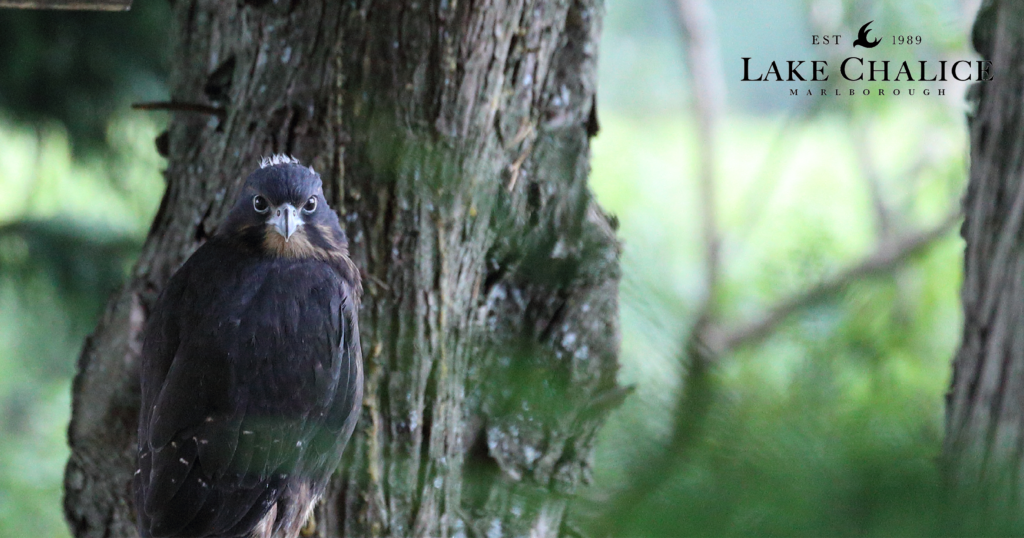2023 Kārearea Release

Lake Chalice Wines was honoured to attend the release of two kārearea chicks last week from their hack box located at our Eyrie Vineyard in the Waihopai Valley . This was a truly magical and heart – warming experience that we would like to share.
The two young chicks were hatched and raised by their kārearea parent facilitator in the Marlborough Falcon Conservation Trust, followed by spending time in their Lake Chalice hack box to adjust to the big wide world before being released into the wild.
The Marlborough Falcon Conservation Trust (MFCT):
The MFCT works incredibly hard to rescue, rehabilitate and increase the population numbers of New Zealand’s last remaining endemic bird of prey in the greater Marlborough area, but they also service the entire South Island. They’ve been operating since late 2008, and have two staff, Diana and Lizzie, as well as a number of volunteers, who feed the birds, maintain the aviary and offer general support. The MFCT have a relatively stable population of breeding pairs, many of whom would not survive in the wild due to life threatening injuries or issues.
Lake Chalice and the MFCT:
We at Lake Chalice have been proud to support such an amazing organisation as the Marlborough Falcon Conservation Trust for a number of years now, with our recent support coming in the form of the hack box at our Eyrie Vineyard in the Waihopai Valley. It provides the juvenile falcons shelter before being released into the wild and within the shelter they are fed and given time to take in the view of the surrounding area every day. We also worked to insulate electrical transformers close to the vineyard to protect the birds. The thinking is, that by giving them time and safe shelter the Falcons will remain in the area once released, until they learn to hunt.
The kārearea:
The New Zealand Falcon, also known as kārearea, is classified as ‘at risk’, with only around 6,000 left in the wild. MFCT and Wingspan in the North Island are the primary organisations in the country to breed and rehabilitate kārearea.
Capable of flying at high speeds, it is the fastest bird in New Zealand, and can catch prey mid-flight, and larger than itself. They have eyesight eight times better than the average human (but not good night vision). The kārearea therefore unfortunately often fall victims of predators (such as stoats and cats), and habitat destruction, which is why Lake Chalice is proud to support the MFCT in their endeavours to conserve the species. They are smaller than you might expect, females weighing around 500 grams, or the size of a magpie, and males weighing around 350 grams.
The Falcon is exceptional at gathering prey, including black shags, poultry and pheasants. They will also hunt mammals such as rabbits and hares. These juvenile chicks will likely feed on insects including cicadas, dragonflies and huhu beetles, especially during this period in which they are learning to hunt for themselves.
Falcon Breeding:
A kārearea pair will mate for life, share nesting incubation and reach adulthood at one year old. They are spring/summer breeders and do not build nests, as you might expect from a bird. In fact, they make a ‘scrape’ on the ground, in a protected spot, in which the female lays its eggs. Their typical clutch consists of between two and four eggs, and it takes around 33 days for them to hatch.
The female guards the chicks closely until the grey down stage come through after hatching. The male is tasked with the majority of the hunting, however both parents feed the chicks. The female joins the hunting once the chicks are warm with grey down. The three phases of a kārearea growth development are; white down, grey down followed by feather.
Was that a Falcon or a swamp Harrier I just saw?
The place you’re most likely to see the Falcon is on the New Zealand $20 note, as unfortunately sightings are not common.
There are a couple of key ways to tell the difference between the two including:
- The kārearea is smaller than the harrier. The harrier is 2.5 times larger than a kārearea.
- Harriers will fly and soar through the air, whereas falcons have a relatively fast and consistent wing beat.
- Falcons will swoop on prey, as opposed to the harrier who glides in search of prey.
- Harriers commonly land and eat roadkill, whereas the falcon will rarely do so.
